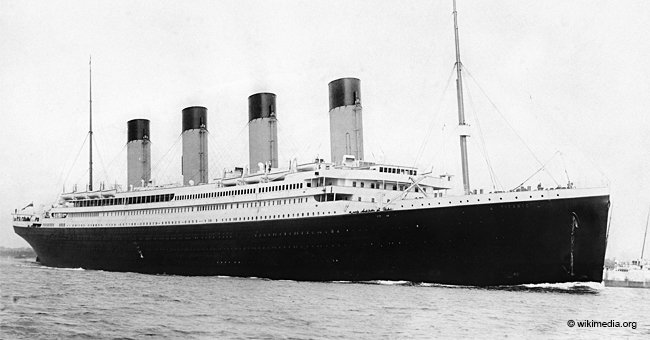
22 Rare Pictures of the Titanic That Prove the Greatness of the Biggest Ship of Its Time
Thought to be the most solid ocean liner to hit the seas, no one ever saw the fate of the Titanic coming with believers even called it “unsinkable”.
Over a century ago the Titanic was the largest passenger ship at sea and the largest man-made moving object on earth. At full capacity, it could carry 3,547 passengers with 833 in First Class, 614 in Second Class, and 1,006 in Third class, with the rest of the allocation for the crew.
It was designed to feel like the posh contemporary hotels with the Ritz Hotel as a reference.
However, the Titanic was fitted with only 20 lifeboats on the ship which could save only one-third of its total passenger list.
Built by the Harland and Wolff shipyard of Belfast with Thomas Andrews as the chief naval architect, it was operated by the White Star Line. Only four days after its departure, the ship collided with an iceberg causing the hull plates to buckle and exposing five watertight compartments to the sea. She was built to survive only four floodings. The British passenger liner sank on her maiden voyage across the North Atlantic Ocean between Southampton to New York City in 1912 taking more than 1,500 lives.
Images of that era give us a better picture of the ship layout and a glimpse at the life on-board the Titanic before it faced its tragic end.
1. The building of the Titanic began in March 1909 and was completed in April 1912.
National Museum of the U.S. Navy [Public domain]
2. The Titanic was launched in May 1911 through the River Lagan.
Internet Archive Book Images [No restrictions]
3. This photo shows the propeller shaft installation.
Robert John Welch (1859-1936), official photographer for Harland & Wolff [Public domain]
4. There weren’t enough lifeboats to save all the passengers on the sinking ship.
Томас Баркер [Public domain]
5. Louis Seize or the style of architecture and furniture that started in France by Louis XVI was used to decorate this cabin room B-58.
Robert John Welch (1859-1936), official photographer for Harland & Wolff [Public domain]
6. A Dutch colonial style was the inspiration of this cabin B-59.
Robert John Welch (1859-1936), official photographer for Harland & Wolff [Public domain]
7. The Titanic was the first to have a heated swimming pool on a sailing vessel.
Bernard Walker Dodd, Mead and Company, New York [Public domain]
8. Found on the First Class Promenade was an elegant coffee show called the Café Parisien.
Robert John Welch (1859-1936), official photographer for Harland & Wolff [Public domain]
9. Rich wood-paneled walls and luxurious fabrics were used in the First Class Lounge.
Robert John Welch (1859-1936), official photographer for Harland & Wolff [Public domain]
10. A reading and writing room was built for the women in First Class where they could play cards and socialize throughout the day.
Robert John Welch (1859-1936), official photographer for Harland & Wolff [Public domain]
11. There was a fitness gym for the men in First Class, as well.
Robert John Welch (1859-1936), official photographer for Harland & Wolff [Public domain]
12. This was the smoking room for the Second Class passengers on the ship.
Robert John Welch (1859-1936), official photographer for Harland & Wolff [Public domain]
13. The upgraded version of the smoking room in First Class was outfitted with mahogany walls and mother of pearl details.
William Herman Rau (1855-1920) [Public domain]
14. The ship’s captain, Edward J. Smith, from Staffordshire, England, was one of the most experienced sea captains and had intended to retire after the Titanic’s maiden voyage.
New York Times [Public domain]
15. These were the surviving officers of the Titanic.
See page for author [Public domain]
16. First Class passenger Rosalie Ida Blun Straus died in the sinking, and her body was not recovered.
See page for author [Public domain]
17. The Goodwin family, also onboard the ship, did not survive.
See page for author [Public domain]
18. Irish Jesuit priest and photographer Francis Browne took photos of the Titanic and some of its passengers.
Father Browne [Public domain]
19. Calm seas made it difficult to spot icebergs, and many survivors said the sea was unusually flat, like glass.
http://ibnlive.in.com/photogallery/3770-1.html [Public domain]
20. Frederick Spedden and his son, Douglas, were among the First Class passengers that survived.
Фрэнк Браун [Public domain]
21. This lifeboat made it to the Carpathia ship.
passenger on the Carpathia [Public domain]
22. The Titanic had its last port of call in Queenstown, Ireland, now called Cobh, Ireland.
See page for author [Public domain]
Aside from the precious lives lost on the ship, many priceless artifacts were also lost to the sea. The wealthiest passengers on board the vessel brought with them their family treasures, as they hoped to sail to America and start their new life there.